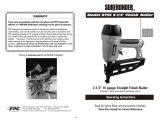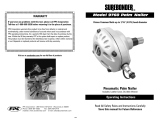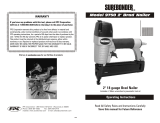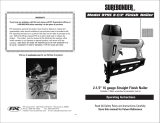Page is loading ...

®
FPC Corporation - 355 Hollow Hill Drive - Wauconda, IL 60084
Phone: (847) 487- 4583 Fax: (847) 487-0174
website: www.surebonder.com e-mail: [email protected]
Read All Safety Rules and Instructions Carefully
Save this manual for Future Reference
0510
Operating Instructions
Brad Nailer
1/4”Crown Stapler
1”- 2-1/2" 16 gauge Finish Nailer
5/8”- 2” 18 gauge
5/8”- 1-5/8” 18 gauge
Includes: Allen wrench(2) & pneumatic oil
Model 7760 3 in 1 Nailer/Stapler
WARRANTY
If you have any problems with this tool, please call FPC Corporation toll-free at
1-800-860-3838 before returning it to the place of purchase.
FPC Corporation warrants this product to be free from defects in material and
workmanship, under normal conditions of use and when used in accordance with
FPC operating instructions, for a period of 90 days from the date of purchase by the
user. Within the 90 day warranty FPC at its option shall repair or replace the
product. . The product must be returned at the distributor/user expense, either
within warranty or out. Repaired or replaced products will receive a 60 day
warranty. USER MUST BE USING THE PROPER FASTENERS FOR THIS WARRANTY
TO BE VALID. WARRANTY IS VOID IF INCORRECT TYPE OF FASTENERS ARE USED.
®
Visit us at surebonder.com for our full line of products

THE SAFETY WARNINGS BELOW CANNOT COVER ALL POSSIBLE SITUATIONS THAT MAY
OCCUR. THESE BASIC SAFETY PRECAUTIONS SHOULD ALWAYS BE FOLLOWED TO PROTECT
AGAINST PERSONAL INJURY TO THE OPERATOR OR OTHER PERSONNEL IN THE AREA, AS
WELL AS DAMAGE TO THE EQUIPMENT. READ AND UNDERSTAND THESE WARNINGS BEFORE
USING EQUIPMENT.
Keep tool away from children, and DO NOT allow children near work area. Do not allow children
or untrained personnel to handle this tool.
DO NOT operate this tool while tired, or under the influence of drugs, alcohol, or medication that
makes you drowsy.
Never point the tool at yourself or others - always assume that the nailer is loaded, and proceed
with caution.
Wear safety glasses and ear protection. The tool operator and all personnel in the work area
must wear safety glasses that protect the front and side, to avoid eye injury. Ear plugs should be
worn to avoid hearing damage.
If operator will be working in a situation where overhead work will be done (i.e. on a ladder,
stairs, or scaffolding) a hard hat must be worn.
Never wear loose clothing or jewelry because it can get caught in the moving parts of this tool.
Make sure long hair is covered, to avoid getting it caught in the tool.
Keep the tool pointed away from yourself and others at all times. Keep hands and all body parts
away from rear area of your tool (near air hose) to guard against injury. Keep hands and feet
away from firing head during use.
Keep proper balance and footing at all times - do not over-reach.
Never use oxygen, bottled gas or any type of combustible fuel as a power source - it can cause
an explosion and serious injury.
Do not use near flammable liquids or gases - the nailer sparks during operation, and could cause
an explosion and serious injury.
Use an air hose that will withstand at least 150 psi, OR 150% of the maximum pressure of the
compressor.
Never connect this tool to compressed air if the pressure could exceed 200 psi, as the tool could
burst. Use only clean, dry, regulated compressed air, with pressure not exceeding 100 psi.
Do not use a non-relieving coupler with this tool - if used, the tool could remain charged with air
after disconnecting, and would still be able to drive a nail even after being disconnected. The
tool and air hose must have a coupling so that all pressure is removed from the tool when the
coupling is disconnected.
Do not depress the trigger or safety mechanism while loading nails or staples - accidental firing
of a nail or staple can occur. Keep your fingers away from the trigger when not firing nails or
staples. Always keep the tool pointed downward during loading.
Do not use an air hose that is too long - tool operator can trip over it. Make sure all connections
are tight.
(WARNINGS continued next page)
Improper use of this tool can result in death or serious injury.
This manual contains important information about product safety.
Read and understand this entire manual before operating this tool.
IMPORTANT SAFETY WARNINGS:
! DANGER
110
To order go to: www.fastener-products.com

Disconnect air hose from tool:
before performing maintenance
when clearing a jam
when tool is not in use
when moving it to another location
when handing tool to another person
DO NOT place finger on trigger when disconnecting air hose - the tool could fire when
reconnected to the air supply.
Carry tool by the handle only, not by the air hose.
Do not drive nails/staples close to the edge of the workpiece. It could split, allowing a
nail/staple to fly or ricochet and causing personal injury. Do not try to drive nails/staples
at too steep an angle. Make sure tool is held firmly during firing to minimize recoil.
Do not drive a nail/staple into very hard material, thin material, or on top of an existing
nail/staple- the nail or staple could ricochet, causing personal injury.
Never use the tool if it is leaking air, the contact safety mechanism is not working, tool
has missing or damaged parts, or requires repair. Make sure all screws and caps are
securely tightened.
Inspect the tool before each use to insure that the trigger, safety mechanism, and spring
are operating properly. Lock the tool in a clean, dry storage area between uses.
Only use parts, nails/staples, and accessories supplied or recommended by FPC
Corporation. Unauthorized parts or fasteners can lead to malfunction and serious injury.
Only personnel trained by FPC Corporation or the distributor shall repair the tool. Do not
modify this tool in any way.
Never use in presence of flammable liquids or gases. The tool produces sparks during
operation.
Never use this tool in sites containing lacquer, paint, benzine, thinner, gasoline, gases,
adhesive agents, and other materials which are combustible or explosive.
Check for live wires. Avoid the risk of electrical shock by checking for live wires that may
be hidden by walls, floors, or ceilings. Turn off the breaker switch pertaining to that work
area.
Do not store this tool in a cold weather environment. Store the tool in a warm area until
the start of work. If it is in a cold area, bring it in a warm area and allow it to warm up
before use.
Manufacturer assumes no responsibility for consequential or indirect damages from the
use of this product.
Save this manual and have it available for tool operators
reference!
IMPORTANT SAFETY WARNINGS: continued
92
7760 3 in 1 Nailer

Troubleshooting
The following form lists the common operating system with problems and solutions. Please read
the form carefully and follow it.
WARNING: If any of the following symptoms appears during your operation, stop using the tool
immediately, or serious personal injury could result. Only qualified persons or an authorized service
center can perform repairs or replacement of tool. Disconnect tool from air supply before
attempting repair or adjustment. When replacing O-rings or cylinder, lubricate with pneumatic tool
oil before assembly.
Problem
Air leak near top of the tool or
in trigger area
Air leak near bottom of tool
Air leak between body and
cylinder cap
Fastener is being driven to
deep
Tool is not operating properly,
cannot drive nail, or operates
sluggishly.
Tool skipping fasteners
Tool Jams
Air exhaust being directed at
operator
Check
O-ring in trigger valve damaged.
Trigger valve heads damaged.
Trigger valve stem, seal, or o-ring
are damaged.
Loose screws.
Worn or damaged o-rings or
bumper.
Loose screws.
Worn or damaged o-ring or seal.
Worn bumper.
Air pressure set too high.
Depth adjustment knob is not
properly adjusted.
Inadequate air supply.
Inadequate lubrication.
Worn or damaged o-rings or seals.
Exhaust port in cylinder head is
blocked.
Worn bumper or damaged spring.
Dirt in front plate.
Dirt or damage prevents nails from
moving freely in magazine.
Worn or dry o-ring on piston.
Incorrect or damaged nails.
Damaged or worn driver guide.
Magazine or nose screw loose.
Magazine is dirty.
Exhaust port direction requires
adjustment.
Solution
Check and replace o-ring.
Check and replace.
Check and replace trigger valve stem,
seal, or o-ring.
Tighten screws.
Check and replace o-rings or bumper.
Tighten screws.
bumper.
Check and replace o-rings or
Replace bumper.
Adjust air pressure.
Adjust depth setting by turning
adjustment knob.
Verify adequate air supply.
Place 3-6 drops of oil into air inlet.
Check or replace o-rings or seals.
Replace damaged internal parts.
Replace bumper or pusher spring.
Clean the drive channel on front
plate.
cleaned.
Nail magazine needs to be
Replace o-ring and lubricate tool.
Make sure correct fasteners are
being used and installed correctly in
the magazine.
Check and replace the driver.
Tighten the magazine.
C
lean the magazine.
Turn or adjust exhaust port away
from operator.
38
APPLICATIONS
Including but not limited to: Casing, Cabinets, Door and Window Trim, Furniture Repair,
Baseboard, Carpet.
FEATURES
- Adjustable Air Exhaust
- Soft Grip handle reduces fatigue
- Lightweight, rugged cast aluminum construction
- Contact safety mechanism - for safe operation
- Protective tip prevents surface damage
- Adjustable depth drive
- Quick release nosepiece for fast jam clearing
- Quick release magazine for easy loading
AIR SUPPLY
NEVER use oxygen or other bottled gases. Explosion may occur.
This nailer is designed to operate on clean, dry, regulated compressed air, between 70 and 100
PSI. It is preferable to include an air filter, pressure regulator, and automatic oiler within 15
feet of the tool, if possible.
An air filter is needed to remove contaminates and moisture that are contained in compressed
air; filtering will significantly prolong the life of the tool. If an automatic oiler is not installed,
place 3 to 6 drops of oil into the tool's air inlet before each work day or after 2 hours of
continuous use-depending on the characteristic of the tool or type of fasteners used. Do not
install a quick coupler directly into the tool. Higher pressure drastically reduces tool life.
The tool comes factory-equipped with a male quick connector. The tool must always be
connected to the air supply with a coupling that removes all pressure when it is disconnected.
NOTE: all components used with this nailer (air hose, connectors, regulators, filters, etc) must
be rated at 120 psi, OR 120% of the maximum compressor potential, whichever is higher. Do
not connect this nailer to a system with maximum potential air pressure greater than 200 psi.
DANGER
!
20
0
40
60 80 100
120
140
160
Lubricator Regulator Filter
To compressor
To Nailer Quick Connector Quick Coupler
AIR CONNECTION SET UP

SPECIFICATIONS
Overall Dimensions: 11.25" x 11.75" x 2.75”
Capacity: 100 fasteners
Operating Pressure: - 100 PSI (4.8-7 bar)
Air Inlet Size: 1 /4”NPT (National Pipe Thread)
Weight of Tool: 5.05 lbs.
FASTENER SELECTION
Use SUREBONDER 500 Series or any other brand
16 gauge - Finishing Nails 1" to 2-1/2” (25mm-64mm)
Use SUREBONDER 400 Series or any other brand
18 gauge - Brad Nails 5/8”to 2” (15mm-50mm)
Use SUREBONDER 350 Series or any other brand
18 gauge - 1/4”Crown Staples 5/8”-1-5/8”
70
(15mm-32mm)
Adjustable
Exhaust Cover
Finishing Nails-Insert in Center Slot
Brad Nails-Insert in Left- Side of Magazine
Staples-Insert staple legs in Center & Side Slot
OPERATION
5
Jam Clearing: Pull down on latch Depth Adjustment: Turn depth Exhaust
and swing guide plate outward. adjustment dial clock-wise to deflector can be positioned
Remove jammed nail, replace increase depth drive and counter- to point in any 360° direction.
guide plate catch and lift latch up. clockwise to decrease depth Reposition deflector by rotating
drive. (when operator is holding to the desired position.
handle with right hand).
Exhaust Deflector:
Depth Adjustment Knob
Turn knob clockwise-for more depth
Turn knob counter-clockwise-for less depth
6
Finishing Nail Brad Nail Staple
16 gauge 18 gauge 18 gauge
1”to 2-1/2"
(25mm-64mm)
5/8” to 1-5/8”
(15mm-41mm)
5/8” to 2”
(15mm-50mm)
To load Finishing Nails: Detach nailer from air supply.
Do not load with contact safety mechanism or trigger
depressed. Push magazine release to release magazine
and slide back. Insert strip of finishing nails into the
center slot at the top of the magazine. (Fig.1). Slide
magazine cover towards the front of the magazine
until it is locked in place.
To load Brad Nails: Detach nailer from air supply.
Do not load with contact safety mechanism or trigger
depressed. Push magazine release to release magazine
and slide back. Insert strip of brad nails into the left-side
of magazine (Fig.2). Slide magazine cover towards the front
of the magazine until it is locked in place.
To load Staples: Detach nailer from air supply. Do not
load with contact safety mechanism or trigger depressed.
Push magazine release to release magazine and slide back.
Insert strip of staples at the top of the magazine with one
leg of the staple in the center slot and the other leg along
the left-side of the magazine (Fig.3). Slide magazine cover
towards the front of the magazine until it is locked in place.
Trigger Quick Release
Magazine
1/4” Male Quick
Release Connector
Rubber Grip
Depth Adjustment
Quick Release
Latch
Guide Plate Catch
Contact Safety Mechanism
Nail Magazine
Loading Finishing Nails, Brad Nails, Staples: (See different methods
of loading all 3 fasteners). Note: Load only one type of fastener at a time.
Dial
Fig. 1
Fig. 2
Fig. 3
1/4”

Mode of Operation
This nailer is equipped with a contact safety mechanism and does not operate unless the contact
mechanism is depressed. There is only one method of operation to drive fasteners with this nailer.
- Intermittent operation (Trigger fire).
- Position the nail outlet on the workpiece with finger off the trigger.
- Depress the contact safety mechanism firmly until it is completely depressed.
- Pull the trigger to drive a fastener.
- Remove finger from the trigger.
- To drive another fastener, pick up and move the nailer along the workpiece and repeat this
procedure.
Lubrication
It is important that the nailer be properly lubricated. Without proper lubrication the nailer
will not work properly and parts will wear prematurely. Use pneumatic tool lubricant. Do not
use detergent oil or additives. These lubricants will harm the O-rings and other rubber parts. This
will cause the nailer to malfunction. Filter-regulator-lubricator units should always be used. Keep
the lubricator filled with pneumatic tool lubricant. If a lubricator is unavailable supply 3 - 6 drops of
pneumatic tool lubricant into the air inlet before each work day or after 2 hours of continuous use-
depending on the characteristic of the tool or type of fasteners used.
Cold Weather Care
Do not store the nailer in a cold weather environment. If the nailer is cold bring the nailer into a
warm area and allow to warm up before use. To warm up the nailer: Reduce the air pressure to 40
psi ( 2.8bar 2.8kgf/cm²). Remove all fasteners from the nailer. Connect the air hose and blank-fire
the nailer. The lowered air pressure will be enough to blank-fire the nailer. Slow speed operation of
the nailer tends to warm the moving parts.
Inspecting the magazine
Disconnect the air hose. Keep magazine and nose of tool clean and free of any dirt, lint or abrasive
particles. Clean the magazine by removing plastic tips or wood chips which may have
accumulated in the magazine. Lubricate it with pneumatic tool lubricant.
Storing
When not in use for an extended period of time apply a thin coat of pneumatic tool lubricant
to the steel parts in order to avoid rust. Do not store the nailer in a cold weather environment.
Keep the nailer in a warm and dry place.
In order to avoid double fire:
- Firmly hold tool down on workpiece to absorb recoil.
- Release trigger quickly.
- Do not drive fasteners into thin boards or near corners and edges of work piece.
- Fasteners can be driven through or away from workpiece and hit someone.
- Never drive fasteners from both sides of a wall at the same time. Fasteners can be driven into
and through the wall and hit a person on the opposite side.
- Never use nailer if it is defective or operating abnormally.
- Do not use nailer as a hammer.
MAINTENANCE
Adjusting Air Pressure
Do not exceed 100 PSI. Adjust the air pressure at the recommended operating pressure 70 to 100
PSI according to the length of nails/staples and the hardness of the workpiece.
The correct air pressure is the lowest pressure which will do the job. Using the tool at a higher
then required air pressure unnecessarily over stresses the Nailer.
Testing The Nailer
Operators and all others within the work area must wear safety glasses
with side shields conforming to ANSI Z87.1 specifications.
Before actually using the nailer, test the nailer using the checklist below.
Disconnect air hose connection from the tool. Remove all nails or staples from the tool.
1) Pull the trigger and push the contact safety mechanism.
THE CONTACT SAFETY MECHANISM AND TRIGGER MUST MOVE FREELY.
2) Adjust the air pressure to 70 psi (4.9 bars 5 kgf/cm²).
Connect air hose.
DO NOT LOAD NAILS OR STAPLES IN THE TOOL.
THE TOOL MUST NOT LEAK AIR.
3) Hold the tool downward without touching the workpiece with the contact safety mechanism.
Pull and hold the trigger for 5 seconds or longer.
THE TOOL MUST NOT OPERATE.
4) Remove your finger from the trigger and press the contact safety mechanism to the workpiece.
THE TOOL MUST NOT OPERATE.
5) If no abnormal operation is observed, you may load fasteners in the tool. If abnormal operation
occurs, stop using the tool and contact the service center immediately.
Loading Finishing Nails, Brad Nails, Staples
When loading Finishing/Brad Nails or Staples into Nailer:
Disconnect tool from compressed air supply.
Do not depress trigger.
Do not depress the contact safety mechanism.
Keep nailer pointed downward.
! WARNING
! DANGER
! WARNING
ANSI Z87.1
74
/









